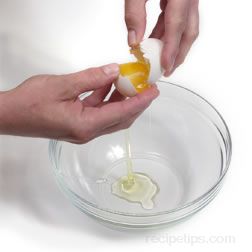Traditional Method | Needle Method | Funnel Method | Separator Tool Method
| It is often necessary to separate egg whites and egg yolks to achieve a successful outcome with a wide variety of recipes; therefore, it is important to learn the proper methods for separating eggs. Beaten egg whites are used in many baked items, such as meringues, cakes, and soufflés, providing air and volume to the dish. Yolks are required for sauces such as hollandaise and mayonnaise and for sweet items such as butter cream frosting and custards. The following information provides a description of four popular methods for separating eggs. |
Traditional Method
|
The traditional method for separating eggs is, perhaps, the most commonly used method. An egg is cracked, and then split in half, allowing the white to fall into a bowl while the yolk is held within the half shell. The contents of the egg are passed back and forth between the two half shells to facilitate the removal of the remaining white from the shell. This procedure allows the white to fall into the bowl as the yolk is transferred back and forth between the shell halves, leaving only the unbroken yolk behind. The yolk is then transferred to a separate bowl for later use. |
|
It is best to use three bowls for this method: one to catch the white as the egg is being separated, one to store the separated whites, and one to store the separated yolks. As the egg is being passed between the shell halves, make sure the yolk does not break and/or spill into the bowl containing the egg white.
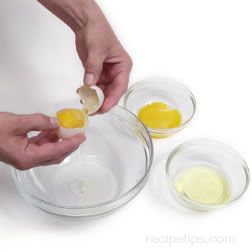
|
Once all of the white has fallen into the bowl, the yolk can be placed into a different bowl for storage. It is also important to transfer the egg white to a different bowl before separating the next egg. This is because when you are separating several eggs, you don't want to risk dropping any yolk into a bowl containing several already separated egg whites. If this happens, it can be difficult to remove the portion of the yolk from the bowl of egg whites. Recipes that require beaten egg whites will be negatively affected by the presence of any yolk, so you may have to start over and waste the egg whites that have already been separated if the egg whites are contaminated with the yolk. This alone should convince you to use THREE bowls when separating eggs with the traditional method.
One negative aspect of the traditional egg separating method is the possibility that the contents of the egg may become contaminated during the procedure. This can happen when the egg is passed back and forth between the shell halves, because bacteria that may be present on the shell could contaminate the egg. Even after the egg is sanitized by the egg processing facility, the shell can become contaminated from contact with other food sources. |
Needle Method
|
A second method that is used for separating the white and the yolk is the needle method.
- A needle is inserted into one end of the egg creating a hole that can be enlarged by moving the needle in a circular manner.
- The egg white will drain slowly through the hole, leaving the yolk behind.
- The egg shell can then be cracked open to remove the unbroken yolk.
|
1
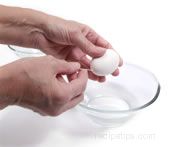
|
2
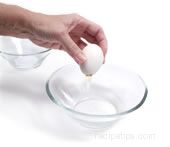
|
3

|
Although this method is easy to do, it can be time consuming for the egg white to drain from the shell. There is also a slight possibility that using this separation method could result in germs, which may exist on the shell, being transferred to the contents of the egg. |
Funnel Method
|
A third method of separating the white and the yolk is the funnel method.
- This method is performed by placing a small funnel over a container and then breaking the egg over the funnel.
- The funnel may need to be tilted back and forth in order to move the yolk away from the neck of the funnel, allowing the white to filter through to the holding container. Care must be taken not to break the yolk when it drops into the funnel or when the funnel is tilted about.
- Once the egg white has slid through the funnel, the yolk and the whites are then transferred to other containers.
|
1
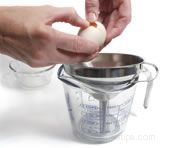
|
2
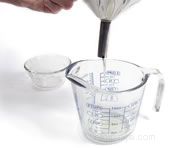
|
3
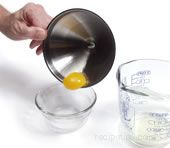
|
The funnel opening must be small enough so that the yolk cannot slide through; yet the opening must be large enough to allow the egg white to slide through easily. This method is quite sanitary because the contents of the egg have very little contact with the outside of the shell. |
Separator Tool Method
|
Perhaps the easiest and most sanitary egg separation method is with the use of a tool specifically designed to separate eggs. The tool is basically a bowl-shaped tray centered in a circular frame with slots positioned around the perimeter.
- When the egg is broken over the separating tool, the egg yolk slides into the center tray where it remains.
- The egg white passes through the slots in the frame and is collected in a container placed beneath the separator.
- The yolk is then transferred to a dish or container.
|
1
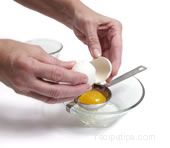
|
2
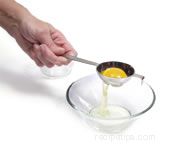
|
3
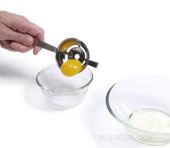
|
Egg separator tools come in different styles and are usually constructed of plastic or metal. The tools are usually quite inexpensive and are available in kitchen supply stores, most department stores, and even in large supermarkets. | |

